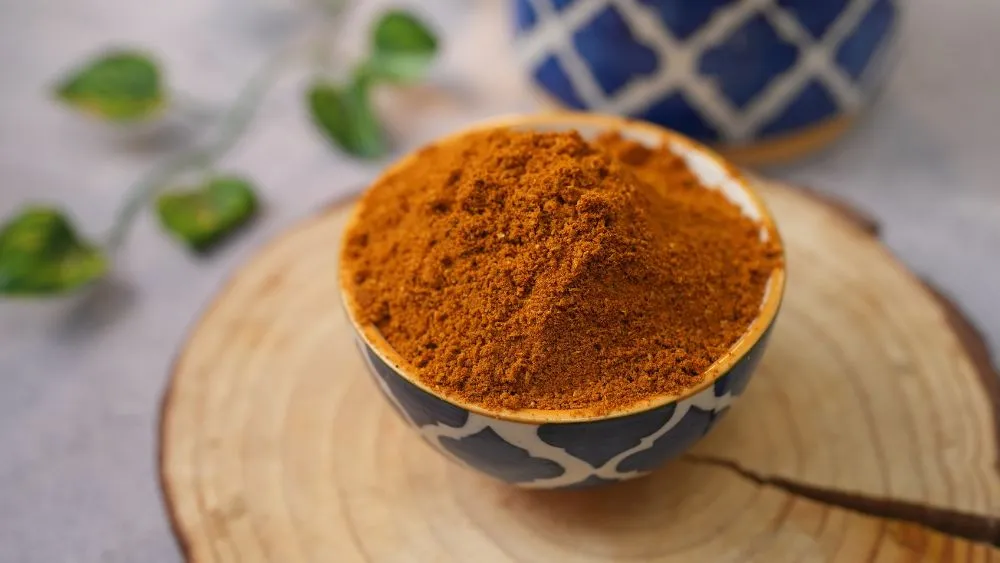
Sabji masala Recipe

15 Mins

6-7 people

5 Mins
Introduction
Hey everyone, it's Chef Ajay Chopra here, and I'm excited to share something special with you today. Have you ever wondered what goes into those aromatic and flavorful masalas that elevate your favorite Indian dishes? Well, today I'm going to show you how to make two essential masalas - Pav Bhaji Masala and Kitchen King or Sabji Masala.
I still remember the first time I tried making these masalas from scratch. It was a moment of revelation for me. The blend of spices, the aroma that filled the kitchen, it was like unlocking a secret to authentic Indian flavors. And since then, I've been passionate about sharing these recipes with all of you.
Recipe of Sabji Masala:
Ingredients:
- Coriander seeds: 2 tbsp
- Jeera (Cumin seeds): 1 tbsp
- Saunf (Fennel seeds): 1 tbsp
- Poppy seeds: 1 tbsp
- Yellow mustard seeds: ½ tbsp
- Methi seeds (Fenugreek seeds): ½ tsp
- Black pepper: ½ tbsp
- Cloves: 5-6 pcs
- Cinnamon: 2 inches
- Bay leaf: 2 pcs
- Green cardamom: 8 pcs
- Black cardamom: 2 pcs
- Mace: 1 pc
- Nutmeg: ½ pc
- Kasoori methi (Dried fenugreek leaves): 2 tbsp
- Hing (Asafoetida): 1 tsp
- Dry ginger powder: 1 tbsp
- Black salt: 1 tbsp
- Kashmiri chilli powder: 1 tbsp
- Turmeric powder: 1 tsp
Method:
- Heat a pan and add all the whole spices.
- Roast them on medium-low flame for 1-2 minutes until fragrant.
- Add the powdered spices and lightly roast them.
- Remove from heat and let them cool down.
- Transfer the roasted spices to a mixer jar and grind them into a fine powder.
- Store the masala in an airtight container for future use.
Recipe of Pav Bhaji Masala Recipe:
Ingredients:
- Bay leaf: 5-6 pcs
- Cinnamon: 2 inches
- Nutmeg: ½ pc
- Star anise: 2 pcs
- Green cardamom: 4 pcs
- Black cardamom seeds: 2 pcs
- Cloves: 8-10 pcs
- Black pepper: ½ tbsp
- Coriander seeds: 4 tbsp
- Jeera (Cumin seeds): 1 tbsp
- Saunf (Fennel seeds): 1 tbsp
- Dagad phool: 1 tbsp
- Black salt: 1 tsp
- Dry ginger powder: 1 tsp
- Amchur powder (Dry mango powder): ½ tsp
- Deggi mirch powder: ½ tbsp
- Hing (Asafoetida): ¼ tsp
Method:
- Heat a pan and add all the whole spices.
- Roast them on medium-low flame for 1-2 minutes until fragrant.
- Add the powdered spices and lightly roast them.
- Remove from heat and let them cool down.
- Transfer the roasted spices to a mixer jar and grind them into a fine powder.
- Store the masala in an airtight container for future use.
About the Recipe
Sabji Masala is a versatile spice blend used in various vegetable dishes across Indian cuisine. Made with a combination of whole and powdered spices, including coriander, cumin, cloves, and more, this masala adds depth and richness to curries, stir-fries, and gravies.
Pav Bhaji Masala, on the other hand, is a quintessential spice mix used specifically in the popular Mumbai street food dish, Pav Bhaji. It consists of a unique blend of spices such as coriander, cumin, fennel, and dried mango powder, creating a robust and tangy flavor profile that perfectly complements the buttery goodness of Pav Bhaji.
Cooking Tips
-
Roasting the Spices: Toast the whole spices gently on low heat to release their essential oils and enhance their flavors before grinding them into a powder.
-
Customization: Feel free to adjust the quantities of spices according to your taste preferences. You can also add or omit certain spices to tailor the masala to your liking.
-
Storage: Store the homemade masalas in airtight containers in a cool, dry place to maintain their freshness and flavor for an extended period.
-
Poppy Seeds: Don't skip adding poppy seeds to the Sabji Masala, as they contribute to the texture and appearance of the final dish, imparting a glossy finish.
-
Grinding: Grind the roasted spices into a fine powder for a smooth and uniform texture, ensuring even distribution of flavors in your dishes.
Pairing Guide
Sabji Masala pairs well with a wide range of vegetable-based dishes, including Aloo Gobi, Paneer Butter Masala, and Bhindi Masala. Its robust flavor profile enhances the taste of any curry or stir-fry, making it a pantry essential for Indian cooking. As for Pav Bhaji Masala, it's best enjoyed in its namesake dish, Pav Bhaji, served with buttered pav (bread rolls) for a satisfying street food experience.
Frequently Asked Questions about Sabji Masala
-
Can I use store-bought spices instead of whole spices for making Sabji Masala?
- While whole spices are preferred for their freshness and flavor, you can use pre-ground spices if that's more convenient. Just be sure to adjust the quantities accordingly.
-
What is the shelf life of homemade Sabji Masala?
- Homemade Sabji Masala can last for several months if stored properly in an airtight container away from moisture and sunlight.
-
Can I customize the spice level of Pav Bhaji Masala?
- Yes, you can adjust the amount of chili powder or add more/less of other spices to control the heat level according to your preference.
-
Is it necessary to roast the spices before grinding for Pav Bhaji Masala?
- Roasting the spices enhances their flavors and aroma, resulting in a more robust and flavorful masala. However, you can skip this step if you prefer a milder flavor.
-
Can I use Pav Bhaji Masala in other dishes apart from Pav Bhaji?
- While Pav Bhaji Masala is specifically formulated for Pav Bhaji, you can experiment with using it in other vegetable-based dishes to add a unique twist to your recipes.
-
What can I substitute for poppy seeds in Sabji Masala?
- If poppy seeds are unavailable, you can omit them or substitute with sesame seeds for a similar texture and appearance.
-
Can I use Sabji Masala in non-vegetarian dishes?
- Yes, Sabji Masala can be used to enhance the flavor of certain non-vegetarian dishes like chicken curry or fish curry, adding a touch of Indian spices.
-
Can I make a larger batch of Pav Bhaji Masala and store it for later use?
- Yes, you can double or triple the recipe for Pav Bhaji Masala and store the excess in an airtight container for future use.
-
Is Pav Bhaji Masala gluten-free?
- Most homemade Pav Bhaji Masala recipes are gluten-free since they use only whole spices and ground spices without any added gluten-containing ingredients.
-
Can I use Pav Bhaji Masala as a seasoning for snacks like popcorn or roasted nuts?
- While Pav Bhaji Masala is traditionally used in savory dishes, you can certainly experiment with using it as a seasoning for snacks to add a unique Indian twist to your snacks.
